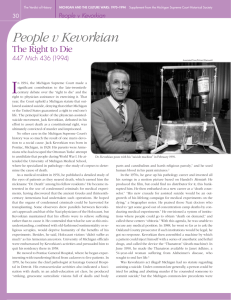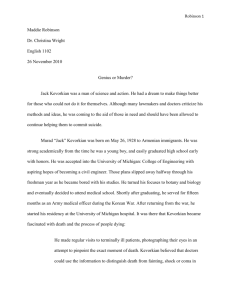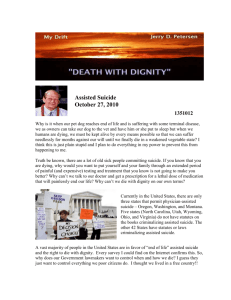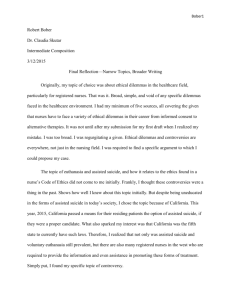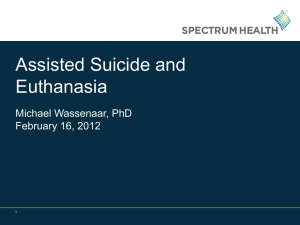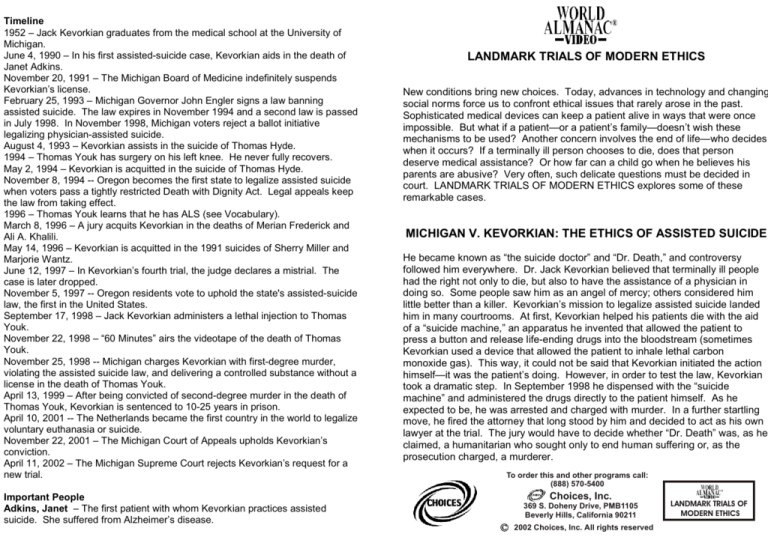
Timeline
1952 – Jack Kevorkian graduates from the medical school at the University of
Michigan.
June 4, 1990 – In his first assisted-suicide case, Kevorkian aids in the death of
Janet Adkins.
November 20, 1991 – The Michigan Board of Medicine indefinitely suspends
Kevorkian’s license.
February 25, 1993 – Michigan Governor John Engler signs a law banning
assisted suicide. The law expires in November 1994 and a second law is passed
in July 1998. In November 1998, Michigan voters reject a ballot initiative
legalizing physician-assisted suicide.
August 4, 1993 – Kevorkian assists in the suicide of Thomas Hyde.
1994 – Thomas Youk has surgery on his left knee. He never fully recovers.
May 2, 1994 – Kevorkian is acquitted in the suicide of Thomas Hyde.
November 8, 1994 -- Oregon becomes the first state to legalize assisted suicide
when voters pass a tightly restricted Death with Dignity Act. Legal appeals keep
the law from taking effect.
1996 – Thomas Youk learns that he has ALS (see Vocabulary).
March 8, 1996 – A jury acquits Kevorkian in the deaths of Merian Frederick and
Ali A. Khalili.
May 14, 1996 – Kevorkian is acquitted in the 1991 suicides of Sherry Miller and
Marjorie Wantz.
June 12, 1997 – In Kevorkian’s fourth trial, the judge declares a mistrial. The
case is later dropped.
November 5, 1997 -- Oregon residents vote to uphold the state's assisted-suicide
law, the first in the United States.
September 17, 1998 – Jack Kevorkian administers a lethal injection to Thomas
Youk.
November 22, 1998 – “60 Minutes” airs the videotape of the death of Thomas
Youk.
November 25, 1998 -- Michigan charges Kevorkian with first-degree murder,
violating the assisted suicide law, and delivering a controlled substance without a
license in the death of Thomas Youk.
April 13, 1999 – After being convicted of second-degree murder in the death of
Thomas Youk, Kevorkian is sentenced to 10-25 years in prison.
April 10, 2001 -- The Netherlands became the first country in the world to legalize
voluntary euthanasia or suicide.
November 22, 2001 – The Michigan Court of Appeals upholds Kevorkian’s
conviction.
April 11, 2002 – The Michigan Supreme Court rejects Kevorkian’s request for a
new trial.
Important People
Adkins, Janet – The first patient with whom Kevorkian practices assisted
suicide. She suffered from Alzheimer’s disease.
LANDMARK TRIALS OF MODERN ETHICS
New conditions bring new choices. Today, advances in technology and changing
social norms force us to confront ethical issues that rarely arose in the past.
Sophisticated medical devices can keep a patient alive in ways that were once
impossible. But what if a patient—or a patient’s family—doesn’t wish these
mechanisms to be used? Another concern involves the end of life—who decides
when it occurs? If a terminally ill person chooses to die, does that person
deserve medical assistance? Or how far can a child go when he believes his
parents are abusive? Very often, such delicate questions must be decided in
court. LANDMARK TRIALS OF MODERN ETHICS explores some of these
remarkable cases.
MICHIGAN V. KEVORKIAN: THE ETHICS OF ASSISTED SUICIDE
He became known as “the suicide doctor” and “Dr. Death,” and controversy
followed him everywhere. Dr. Jack Kevorkian believed that terminally ill people
had the right not only to die, but also to have the assistance of a physician in
doing so. Some people saw him as an angel of mercy; others considered him
little better than a killer. Kevorkian’s mission to legalize assisted suicide landed
him in many courtrooms. At first, Kevorkian helped his patients die with the aid
of a “suicide machine,” an apparatus he invented that allowed the patient to
press a button and release life-ending drugs into the bloodstream (sometimes
Kevorkian used a device that allowed the patient to inhale lethal carbon
monoxide gas). This way, it could not be said that Kevorkian initiated the action
himself—it was the patient’s doing. However, in order to test the law, Kevorkian
took a dramatic step. In September 1998 he dispensed with the “suicide
machine” and administered the drugs directly to the patient himself. As he
expected to be, he was arrested and charged with murder. In a further startling
move, he fired the attorney that long stood by him and decided to act as his own
lawyer at the trial. The jury would have to decide whether “Dr. Death” was, as he
claimed, a humanitarian who sought only to end human suffering or, as the
prosecution charged, a murderer.
To order this and other programs call:
(888) 570-5400
Choices, Inc.
369 S. Doheny Drive, PMB1105
Beverly Hills, California 90211
2002 Choices, Inc. All rights reserved
LANDMARK TRIALS OF
MODERN ETHICS
Cooper, Jessica – Judge at Kevorkian’s fifth trial, in which he is accused of the
murder of Thomas Youk.
Dragovic, Lguibsa – Oakland County medical examiner who testifies that
Kevorkian committed homicide.
Fieger, Geoffrey – Kevorkian’s attorney in his first four trials. He does not
participate in the murder trial because Kevorkian prefers to act as his own
attorney.
Frederick, Merian – A victim of ALS (see Vocabulary), whom Kevorkian helps to
commit suicide, an act for which he is put on trial in 1996.
Gehrig, Lou – Hall of Fame New York Yankee first baseman and most famous
victim of ALS. Died in 1941 at age 37. Because of him, ALS is often called “Lou
Gehrig’s disease.”
Girsh, Faye – Member of the Hemlock Society (see Vocabulary). A Kevorkian
supporter who sees his murder trial as an opportunity to change the law on
assisted suicide.
Gorosh, David – Kevorkian’s attorney during his murder trial. He only assists,
however, as Kevorkian conducts the defense himself.
Heinzmann, Scott – Anti-Kevorkian protester.
Hyde, Thomas – An ALS victim who Kevorkian helps to die by breathing in
carbon monoxide (see Vocabulary).
Kenney, Thomas – Prosecutor in Kevorkian’s trial for the death of Thomas
Hyde.
Kevorkian, Jack – Retired Michigan pathologist (see Vocabulary) who became
famous in the 1990s for advocating and practicing assisted suicide.
Khalili, Ali A. – A victim of bone cancer whom Kevorkian helps to commit
suicide, an act for which he is put on trial in 1996.
Potter, Marianne – Hospice nurse who takes care of Thomas Youk at the end of
his life. She doesn’t believe in assisted suicide.
Skrzynski, John – Prosecutor in Kevorkian’s murder trial.
Wallace, Mike – Television correspondent who interviews Kevorkian for the
news program “60 Minutes” and airs the videotape of Thomas Youk’s death.
Youk, Melody – Thomas Youk’s wife.
Youk, Terry – Thomas Youk’s brother.
Youk, Thomas – 52-year-old victim of ALS to whom Kevorkian administers a
lethal injection, resulting in Kevorkian’s trial for murder.
Vocabulary
ALS – Amyotrophic lateral sclerosis. A progressive neurodegenerative disease
that attacks nerve cells in the brain and the spinal cord. Patients in the later
stages of the disease become totally paralyzed, although their minds remain
unaffected.
carbon monoxide – A colorless, odorless, tasteless, and highly poisonous gas.
Jack Kevorkian used it in several of his assisted suicides.
electrocardiograph – A device that records the electrical activity of the heart
and is usually used to diagnose heart abnormalities. Kevorkian uses one to
determine that Thomas Youk is dead.
patient’s right to choice at the end of life.
euthanasia – The act of putting a terminally ill or injured person to death in a
painless manner in order to end that person’s suffering (the term is also
sometimes applied to the mercy killing of animals).
Hemlock Society -- A nonprofit association, founded in 1980, that supports a
patient’s right to choice at the end of life.
pathology – The study of the causes of disease and of the changes that
diseases cause in the body. Kevorkian was a retired pathologist when he took
up the cause of assisted suicide.
Things to Think About
·
·
·
·
·
The prosecutor said that the trial was not about a patient’s “right to die” but
about Kevorkian’s “right to kill.” However, Kevorkian claimed that his
intention was always to “end a patient’s suffering,” not to “kill” him. Do you
find the prosecutor’s argument persuasive? If the result of ending
someone’s suffering means that that person dies, do you see a difference
between ending suffering and killing someone?
The documentary shows examples of some strange paintings that
Kevorkian did earlier in his career. Do you think these images are
evidence of a vigorous artistic talent or the sign of a troubled mind?
Do you think it was unfair that Terry Youk and Melody Youk were not
allowed to testify at the trial? If they had, do you think the outcome would
have been different?
Kevorkian stated that he was fighting for “a fundamental freedom we all
possess”—that is, the right to die with dignity. Do you think that is a
fundamental right, even if it includes suicide? If you had been a voter in
Oregon, would have approved the ballot measure that allowed physicianassisted suicide?
In his summation, the prosecutor used the term “final solution” to describe
Kevorkian’s activities—this was the term that the Nazis applied to their
murder of some 6 million Jews during World War II. Do you think he was
going too far by, as the documentary put it, equating euthanasia with
genocide? Or was the difference only a matter of numbers?
LANDMARK TRIALS OF MODERN ETHICS
Internet Resources
http://www.kevork.org/ -- A Web site devoted to Kevorkian’s career, with a
large number of articles on his trials, beliefs, patients, and so on.
http://www.fansoffieger.com/chronology.htm – From a Web site devoted to
Geoffrey Fieger, a useful chronology of Kevorkian’s career. The site also
contains other information on Kevorkian and regular updates on his status.
http://www.pbs.org/wgbh/pages/frontline/kevorkian/ -- From PBS, an
excellent site called “The Kevorkian Verdict,” including information about his life
and career and about the legal issues raised by his advocacy of physicianassisted suicide.
http://www.rights.org/deathnet/Kevorkian_one.html – A site called “The
Kevorkian File,” with a description of his activities and patients, as well as
“Opposing Views.”
http://www.courttv.com/casefiles/kevorkian/kevorkian.html – From Court TV,
a detailed site on Kevorkian with an extensive file of news stories about his
career.
http://www.lwc.edu/administrative/library/death.htm – From Longwood
University, a chronology of events regarding physician-assisted suicide in
general.
http://www.lwc.edu/administrative/library/suiart.htm -- A guide to journal and
newspaper articles, hearings, court proceedings, and decisions on physicianassisted suicide.
http://www.deathwithdignity.org/index2.htm -- The W eb site of the Death
with Dignity National Center, an organization that is devoted to “expanding
end-of-life choices and advancing the legalization of physician aid in dying.”
http://www.hemlock.org/ – The home page of the Hemlock Society.
http://www.acponline.org/journals/annals/01apr98/pasdebat.htm – From the
Annals of Internal Medicine, a scholarly paper on “The Debate over PhysicianAssisted Suicide.”
Other Resources
Betzold, Michael. Appointment With Doctor Death. Momentum Books, 1993.
Dworkin, Gerald L., et.al. Euthanasia and Physician-Assisted Suicide.
Cambridge University Press, 1998.
Dzwonkowski, Ron, ed. The Suicide Machine. Detroit Free Press, 1997.
Hendin, Herbert. Seduced by Death: Doctors, Patients and Assisted Suicide.
Norton, 1998.
Hillyard, Daniel and Dombrink, John. Dying Right : the Death with Dignity
Movement. Routledge, 2001.
Kevorkian, Jack. Prescription Medicide: The Goodness of Planned Death.
Prometheus Books, 1993.
Moreno, Jonathan D. Arguing Euthanasia: The Controversy over Mercy Killing,
Assisted Suicide, and the “Right to Die.” Simon and Schuster, 1995.
Quill, Timothy E. Death and Dignity: Making Choices and Taking Charge.
Norton, 1994.
Smith, Wesley J. Forced Exit: The Slippery Slope from Assisted Suicide to
Legalized Murder. Times Books, 1997.
LANDMARK TRIALS OF MODERN ETHICS


